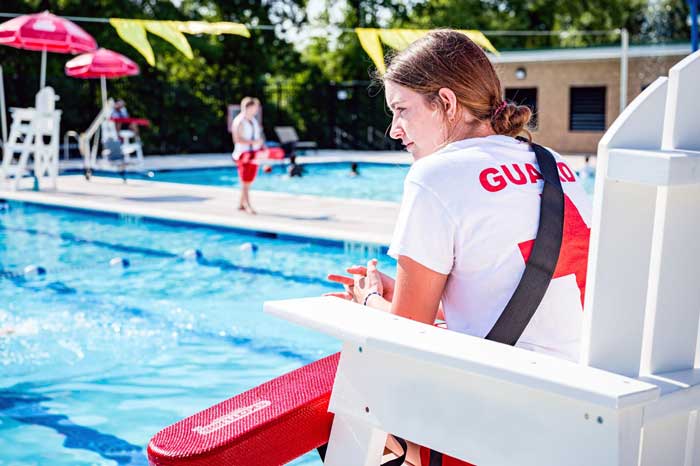What is the ROI of aquatic facility safety?
It doesn’t seem right to even wonder that, given that the goal of safety in and around the water is to save lives and maintain good health, but there’s no doubt that the highest standards of safety cost money.
Staffing is a major expense, as are continual training and certification, and equipment that grows more expensive as its ties to technology increase—and that’s just drowning prevention. Keeping water safe to swim in and air safe to breathe involves the latest in chemical distribution systems and monitoring software and HVAC design.
Companies manufacture the equipment and design the software, and facility managers handle the day-to-day of safety in their buildings, and they all know that regardless of what safety costs, the lack of safety costs much more even after the price of human suffering is paid.
“Many do not realize the ROI since they are effective at safety and do not have an incident that would counteract that,” said Craig A. Merkey, associate director of Recreation & Aquatics at Penn State Harrisburg. “I would think most budget-minded people are not even thinking of the cost of an emergency and hope their insurance coverage will be sufficient to cover these items. I may be wrong, but I do know that the money spent for training and safety of our swimmers is much less than an incident/accident.”
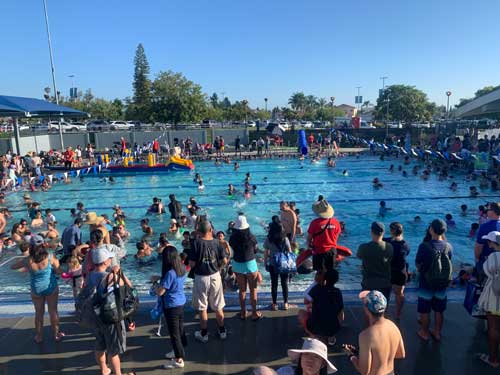
Gwen Willcox, community services manager for the City of Temecula, Calif., said the return on investment of aquatic safety includes many different layers. The most obvious is a reduction in drowning and injury-related costs for the facility, which can lead to lawsuits, attorney’s fees, settlements, and increased insurance premiums.
In addition, investing in safety will lead to a better community perception of the programs and facilities, which will transfer into customer confidence and loyalty. This loyalty and customer confidence will eventually lead to more customers returning and positive word-of-mouth advertising from happy customers, translating into increased revenue for the facility. Many insurance providers offer lower premiums to facilities that can demonstrate specific safety protocols, resulting in savings in operating expenses, said Willcox.
Investing in aquatic safety can also lead to a better work environment for staff and a workforce excited to return year after year. Aquatic professionals, including lifeguards, are trained on how vital aquatic safety is.
“Employees who feel confident, competent, and supported—with training, adequate staffing, and equipment—to provide the safety protocols they have been trained to follow are more likely to stay in their positions longer,” she said. “Returning staff reduces the cost of training new staff and improves facility safety as they get more proficient at their jobs with experience. Proper preventive maintenance on the facility, pool, and pump room equipment can reduce the cost of repairs and help to avoid a complete shutdown of the facility due to equipment or mechanical failure, which would result in lost revenues. Investing in aquatic safety can seem expensive upfront, but the return on this investment will pay off in many ways.”
Drowning Prevention
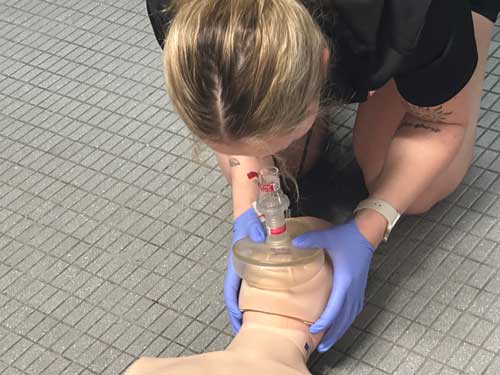
According to the Centers for Disease Control and Prevention (CDC), there are 4,000 fatal drownings and 8,000 non-fatal drownings a year in the U.S. Non-fatal drownings can result in a range of outcomes, from no ongoing injuries to brain damage and permanent disability.
If you tell a facility manager that only 19% of all drownings (fatal and non-fatal) occur where lifeguards are present, don’t expect them to breathe a sigh of relief. That’s still too high, and more can always be done to lower that number.
“There is no cost too great when it comes to the health and safety of those individuals that enter our swimming pools,” said Association of Aquatic Professionals Executive Director and CEO Juliene Hefter. “Fatal and non-fatal drownings at your facilities can and do cost millions of dollars. No amount of money can bring someone back, and no shortcuts should be taken.”
Hefter said training is one of the most important aspects of running and operating a safe aquatic facility, from training lifeguard and swim instructor staff to weekly and monthly in-service trainings of a minimum of four hours per month to ensuring there is a certified aquatic facility operator on staff, as well as providing additional training or educational opportunities to individuals throughout the year.
Adding technology options as an additional layer of protection can be another avenue to help improve the safety of everyone that enters your facility, she said. “Investigating that technology and knowing that it does not take the place of lifeguards providing constant, direct, uninterrupted supervision at all times is imperative, but any additional layer of protection to assist you should definitely be considered,” said Hefter.
Willcox has been in the aquatic industry for more than 30 years, and has seen many changes and improvements to swimmer safety. “I remember the introduction of the rescue tube to pool lifeguarding, emergency oxygen, bag valve masks, automated external defibrillators, and changes in CPR and rescue breathing, to name a few,” she said. “These changes seemed foreign at the time but have saved lives and improved outcomes.”
Other areas where Wilcox has seen a lot of changes and growth include a focus on water safety, more standardized best practices for lifeguarding, facility management, emergency response, and increased training as outlined by the Model Aquatic Health Code (MAHC), as well as state and local regulations.
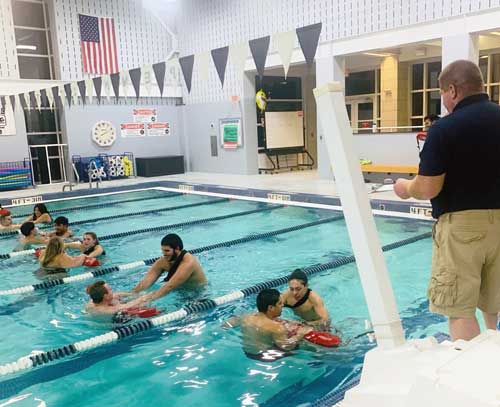
“Over the past 30 years, the aquatics industry has focused more on the prevention of drownings or injuries through water safety training and improved training for lifeguards to include more training on scanning, rule enforcement, awareness, and inattentional blindness, to name a few,” she said. “One of the latest developments includes virtual reality training to improve scanning techniques.”
The latest technology designed to assist lifeguards and facilities is AI monitoring of water above and below the surface. When it detects out-of-the-ordinary movements, it sends alerts. No one doubts the effectiveness, but it is another cost, and not a substitute for human monitoring, said Cory Hilderbrand, community services manager for the city of Irvine, Calif.
“We believe the most common mistake is replacing lifeguards with AI instead of using AI to enhance safety as an addition to lifeguards,” Hilderbrand said. “We believe a safe environment is accomplished through vigilant, highly trained lifeguards and by maintaining staffing at appropriate levels. Although this may create increased staffing costs, it mitigates risk by ensuring a lower swimmer/lifeguard ratio.
“Creating a staffing plan independent of AI would be the first step, and then would integrate AI into the safety plan. AI would never replace the need for actual lifeguards in our opinion.”
Hilderbrand’s opinion is common among aquatic facility professionals; there’s no getting around the value of humans monitoring the water and knowing what to do when help is needed. As with most businesses, labor is a top expense, and the shortage of lifeguards that began before COVID and was exacerbated by pool shutdowns during the pandemic is now not as bad as it was, but still a headache. Wages and bonuses have risen in response, and the expense of initial and ongoing training is continuous, said Sean Lynch, aquatic safety and rental manager at the Indiana University Natatorium in Indianapolis.
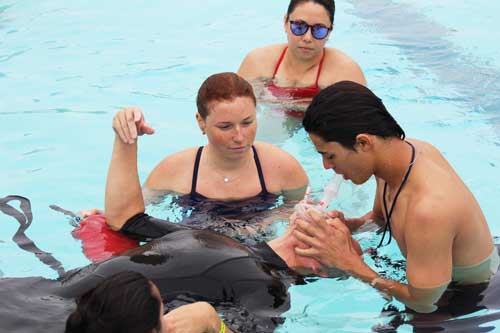
“The bulk of the costs come from the training—always having ongoing training to keep skills at a ‘test-ready level,’ having new lifeguards coming in and certifying them, as well as recertifying guards who have been on staff,” said Lynch.
“Then having to have the technology to train them, because we do live in a digital world now, whether we like it or not. The financial ROI will likely never be fully appreciated. But always having trained safety professionals, whether lifeguards or physical trainers, on staff is always going to be worth it.”
Sue Wheeler, supervisor of the RiverPlex and Aquatics for the Peoria (Ill.) Park District, said that other than the new tools that can provide an additional layer of protection to lifeguards, a major change to staffing has been the switch from rectangular pools to all sorts of pool shapes and attractions and features.
“There is no room for short-changing and trying to cut corners in staffing,” Wheeler said. “You need to be strategic, and you may have to think outside the box when staffing. When you begin to take the shortcuts, you begin to roll the dice in regard to safety.
“It was less expensive supplying staff for rectangular flat-water pools, but society said those flat-water pools were no longer ‘fun.’ So, we have created enormous, architecturally beautiful facilities that require a substantial amount of staff to operate safely and effectively. Communication has had to change just for the fact of the size of the facilities today.”
Water and Air Quality
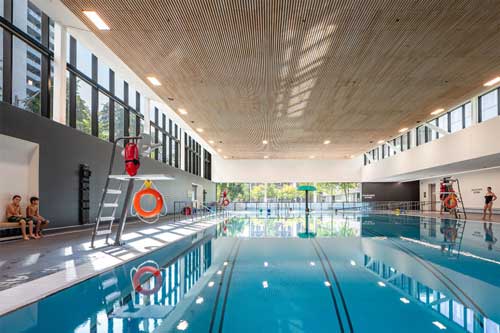
Aquatic safety has undergone substantial transformation, especially with the rise of technology and better facility designs, said Richard Lindhorn, vice president of marketing and corporate development for a company that helps facilities with water quality and safety. New monitoring systems track water quality, detect potential hazards, and automatically alert staff to irregularities, said Lindhorn, and these systems help facilities maintain safe conditions with minimal human intervention. Additionally, many modern pools include features like automatic chemical dosing systems, real-time monitoring of pool conditions—temperature, pH, chlorine levels—and advanced filtration systems that ensure cleaner, safer water.
“With facility design, we’ve seen pool designs are increasingly optimized for safety, with non-slip surfaces, clear depth markers, better barriers, and access to easy exits in case of emergency,” said Lindhorn. “And with the growing emphasis on well-being, facilities are not just focused on accident prevention, but also on providing a safe and healthy environment for rehabilitation, therapy, and recreation.”
Lindhorn said a common challenge is failing to perform consistent checks and upkeep on pool systems, such as filtration, leak prevention, and water quality automation, which can lead to safety issues. He said regular maintenance is crucial to prevent the breakdown of key safety equipment and systems. Another frequent issue is overlooking water quality, he said. Pools require constant monitoring to ensure the water is balanced and free of harmful pathogens. Operators sometimes under-invest in water treatment technology, leading to unsafe conditions.
“Additionally, poor signage and accessibility can be problematic,” Lindhorn said. “Without clear and visible safety signs or ensuring facilities are fully accessible for individuals with disabilities, confusion and accidents can occur.”
Lastly, there is often a lack of proactive risk management, said Lindhorn. Pool operators may address issues only after they arise, whereas proactive measures, such as installing water quality sensors, surveillance systems, or emergency alarms, can significantly reduce risks.
Water quality maintenance has a different sort of ROI, Lindhorn said, that can be improved by an anticipatory rather than responsive approach. “Maintaining a safe aquatic environment involves considerable costs, particularly if a reactive approach is taken,” Lindhorn said. “Technology implementation, such as advanced water quality monitoring systems, automatic chemical dosing systems, and alarm systems for detecting drowning or water level issues, can be expensive upfront but provide long-term value in preventing accidents and ensuring safety.”
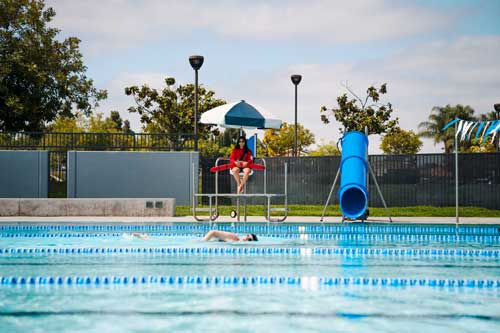
Lindhorn said regular maintenance is also vital and includes the upkeep of pool filtration systems, emergency equipment like life rings and throw ropes, water monitoring systems, and safety barriers.
“Continuous investment is necessary to avoid unexpected failures,” Lindhorn said. “Upgrading infrastructure—such as nonslip flooring, secure pool barriers, and automated emergency shutoffs—can be costly, but these improvements are essential for reducing risks and complying with safety regulations.”
The financial ROI of safety investments in aquatic facilities can be substantial, said Lindhorn. Lower accident-related costs are a key benefit, as investing in water quality monitoring systems, alarms, and advanced filtration helps prevent injuries and reduces liability claims, medical expenses, and legal fees. Insurance savings are another financial advantage, as many providers offer discounts to facilities with proactive safety systems, such as those that track and manage water quality or have automated alerts.
“Operational cost savings are achieved through technology that streamlines processes, reduces the need for manual checks, and optimizes energy and resource use, leading to significant long-term savings,” he said. COVID significantly shifted safety protocols, particularly regarding hygiene and capacity management, Lindhorn said. Sanitation standards were heightened, with more frequent cleaning of high-touch areas, pool equipment, and lounge furniture. Although these measures are now less stringent than during the height of the pandemic, cleanliness remains a priority.
Many facilities adopted contactless solutions, such as digital signage, online bookings, and contactless payment systems, which have become standard operations for efficiency and safety, said Lindhorn. During the pandemic, reduced capacity and social distancing were enforced. While most facilities have returned to full capacity, lessons about crowd management and personal space have influenced ongoing practices. Indoor pools also saw an increased focus on air quality, with many facilities upgrading HVAC systems to improve air circulation and enhance safety.
Ideally, a present-day multi-use facility would integrate smart technologies, advanced infrastructure, and continuous monitoring systems, said Lindhorn. A state-of-the-art water management system would automate chlorine levels, pH balance, and temperature, with alerts sent to management if any parameters deviate from safety standards. Automated chemical dosing systems would maintain water quality without manual intervention, reducing the risk of imbalances or human error.
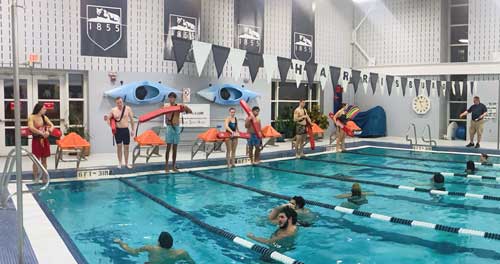
Jeremy Stiles, vice president of risk management for the YMCA of Greater Boston, said facilities are now being designed and built with dedicated chemical storage, built-in safety systems and redundancies, better color coding and labeling of equipment, and facilities that provide a high level of operational efficiency.
“Pool chemical and mechanical equipment is constantly updating and improving,” said Stiles. “We have come a long way since the first sand filters and now have filtration equipment that can filter down to one micron, achieve 3 log cryptosporidium removal (a 99.9% reduction in the presence of cryptosporidium), and increased life spans of up to 30 years, as well as equipment that requires far less staff intervention to keep running as designed.
“The same is true for automated chemical controllers, chemical feed equipment, and supplementary equipment to increase sanitation and cleanliness.”
Lindhorn spies the future of facility water safety as involving fully integrated smart infrastructure that could optimize chemical adjustments, temperature regulation, water flow, and lighting based on real-time data to enhance safety and comfort. Sustainability will also play a larger role, he said, with safety systems incorporating energy-efficient pumps, filtration systems, and water recycling technologies to reduce environmental impact.
“Furthermore, aquatic facilities could collaborate more closely with public health authorities to monitor health trends, track waterborne illnesses, and adopt data-driven approaches to enhance pool hygiene and swimmer safety,” said Lindhorn.
People Power
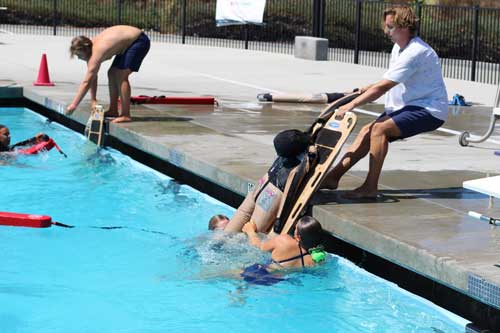
The universal feeling from facility managers is that aquatic safety is controlled by humans; even when equipment and technology are vital pieces, someone had to choose them and pay for them, and someone must react accordingly when monitoring alarms go off.
Staff selection, initial and ongoing training are paramount, as is the equipment the staff uses to do its job of keeping swimmers safe. For instance, portable lifeguard chairs enhance the ability of lifeguards to move to where the action is, said Lisa Adams, marketing manager for a company that makes a variety of pool equipment.
The design and materials used for lifeguard chairs may be an afterthought to the lifeguards, but they can help increase lifeguard comfort and effectiveness with features like swiveling seats and footrests, all made with materials that resist humidity and UV rays. “These features ensure that lifeguards can stay at their posts longer without sacrificing comfort, ultimately contributing to a safer swimming environment,” said Adams.
Life jackets are also gaining support for use in facilities, said Tom Griffiths, Ed.D., founder of Aquatic Safety Research Group. “In a perfect world, always have at least two lifeguards on duty, and always place weak and non-swimmers in United States Coast Guard lifejackets in all bodies of water,” said Griffiths. “Lifejackets are our cheapest and most effective drowning prevention strategy.”
Ultimately, stakeholders of aquatic safety want to see swimmer education as early in a child’s life as possible, and best practices made official in facilities regardless of location, so there is no doubt about priorities, said Hefter.
“I would truly like to see rules and regulations that everyone must follow,” she said. “There are still too many gray areas in aquatic codes, policies, and procedures between states, and there are way too many exceptions. For community and school aquatic facilities there should be no exception to the rule that a separate certified lifeguard be on duty at all times, having no other duties assigned to them but watching those in and around the pool area.
“Each facility is different based on the layout, options included, etc., however, in-depth safety plans and staffing plans for each area would be developed with full coverage being offered at all times.”
Lynch is hopeful that his goals for safety are shared by all in the industry. “I’d like to see a future where everyone is passionate about safety and understands that the risks of drowning are not limited to just big waterparks or weak swimmers,” he said. “A children’s pool with an Olympic-level swimmer in it should be treated with the same level of safety as a wave pool with weak or non-swimmers in it.” RM



